
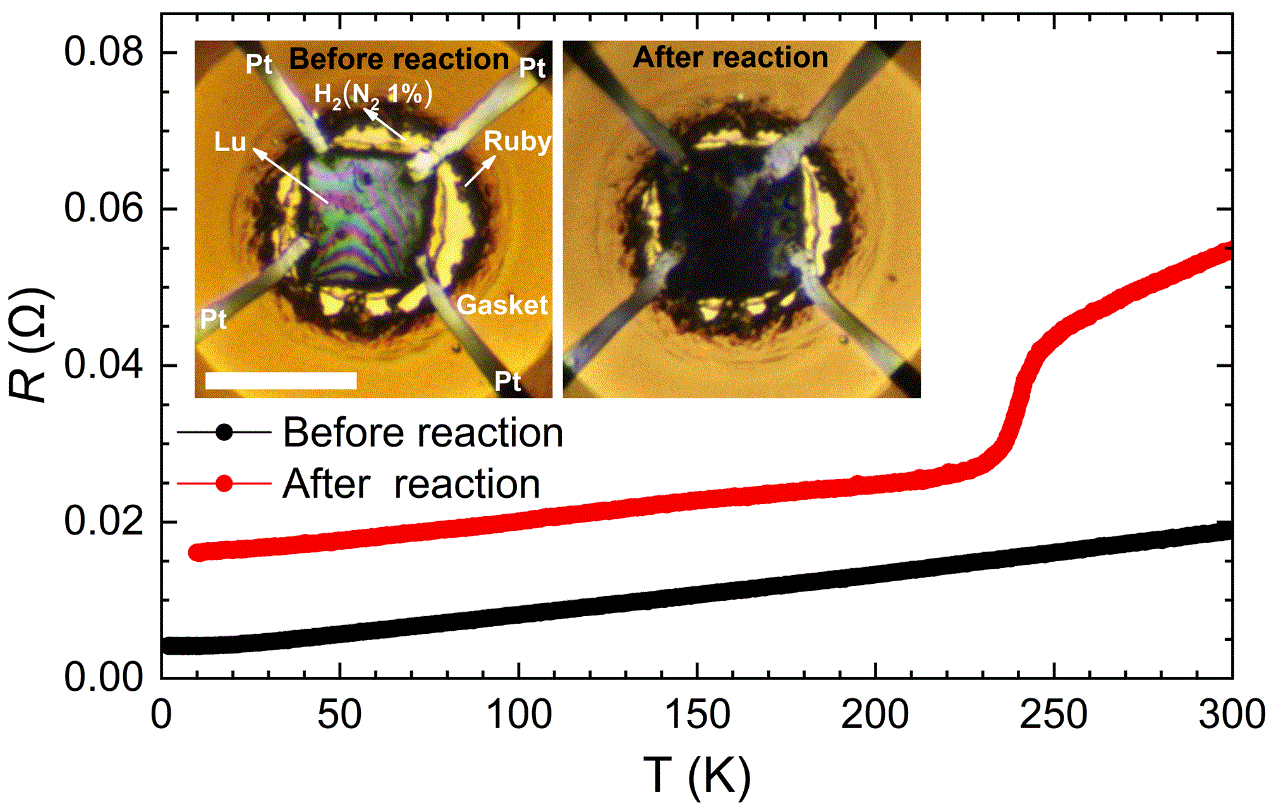 Dec 30, 2023 — A research team led by Drs. Qiaoshi Zeng and Ho-kwang Mao from Center for High Pressure Science and Technology Advanced Research (HPSTAR) repeatedly reproduced the near-room temperature resistance transition in the reaction products (Lu-H-N) of Lu with hydrogen-nitrogen mixture by employing in-situ high-pressure four-probe electrical transport measurement technique to monitor the entire reaction process under different conditions (pressure, temperature, and time). With this reliable experimental protocol, they explicitly reveal that the near-room temperature resistance transition in the Lu-H-N did not result in zero resistance, nor did it exhibit magnetic suppression, ruling out the possibility of any superconductivity. Instead, the resistance transition is suggested to be related to an order-to-disorder transition of hydrogen octahedral vacancies in non-stoichiometric lutetium hydrides, which leads to a metal-to-semiconductor/insulator transition with drastic resistance change. This study overturns the sensational "near-room temperature superconductivity" phenomenon in the Lu-H-N system. The related findings, titled "Origin of the near-room temperature resistance transition in lutetium with H2/N2 gas mixture under high pressure," were published in a recent issue of the National Science Review. (--more)
Dec 30, 2023 — A research team led by Drs. Qiaoshi Zeng and Ho-kwang Mao from Center for High Pressure Science and Technology Advanced Research (HPSTAR) repeatedly reproduced the near-room temperature resistance transition in the reaction products (Lu-H-N) of Lu with hydrogen-nitrogen mixture by employing in-situ high-pressure four-probe electrical transport measurement technique to monitor the entire reaction process under different conditions (pressure, temperature, and time). With this reliable experimental protocol, they explicitly reveal that the near-room temperature resistance transition in the Lu-H-N did not result in zero resistance, nor did it exhibit magnetic suppression, ruling out the possibility of any superconductivity. Instead, the resistance transition is suggested to be related to an order-to-disorder transition of hydrogen octahedral vacancies in non-stoichiometric lutetium hydrides, which leads to a metal-to-semiconductor/insulator transition with drastic resistance change. This study overturns the sensational "near-room temperature superconductivity" phenomenon in the Lu-H-N system. The related findings, titled "Origin of the near-room temperature resistance transition in lutetium with H2/N2 gas mixture under high pressure," were published in a recent issue of the National Science Review. (--more)
Accelerated relaxation dynamics in compressed cerium-based metallic glass
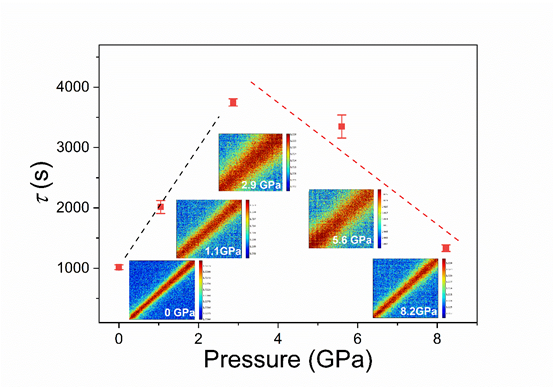 June 5, 2023 — A major stumbling block in our understanding of glass and glass phenomena is the elusive relationship between relaxation dynamics and glass structure. A team led by Dr. Qiaoshi Zeng from HPSTAR recently developed a new in situ high-pressure wide-angle x-ray photon correlation spectroscopy method to enable atomic-scale relaxation dynamics studies in metallic glass systems under extreme pressures. The study is published in the latest Proceedings of the National Academy of Sciences (PNAS) edition. (--more)
June 5, 2023 — A major stumbling block in our understanding of glass and glass phenomena is the elusive relationship between relaxation dynamics and glass structure. A team led by Dr. Qiaoshi Zeng from HPSTAR recently developed a new in situ high-pressure wide-angle x-ray photon correlation spectroscopy method to enable atomic-scale relaxation dynamics studies in metallic glass systems under extreme pressures. The study is published in the latest Proceedings of the National Academy of Sciences (PNAS) edition. (--more)
Capturing high pressures in diamond capsules - Drs. Zhidan Zeng and Charles Zeng
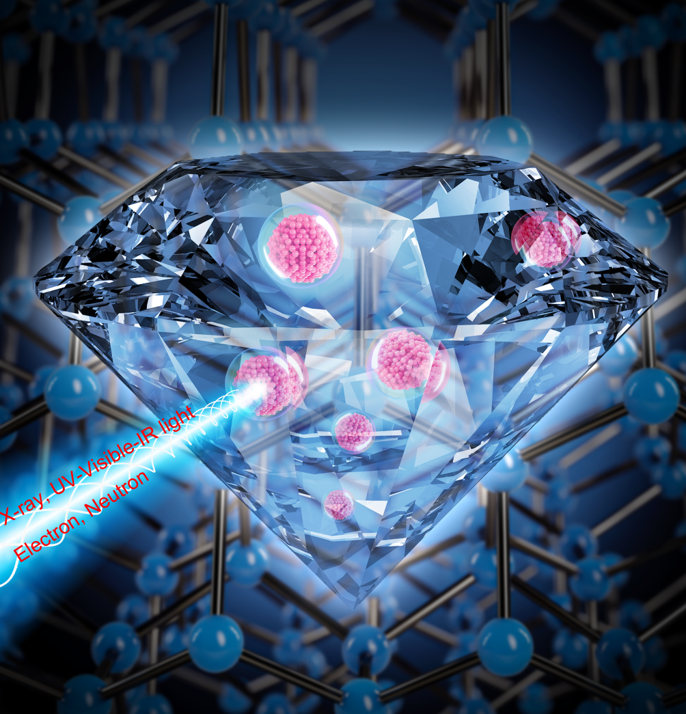
AUGUST 17, 2022 — Preservation of the high-pressure states of materials at ambient conditions is a long-sought-after goal for fundamental research and practical applications. A team of scientists led by Drs. Zhidan (Denise) Zeng, Qiaoshi Zeng, and Ho-Kwang Mao from the Center for High Pressure Science and Technology Advanced Research (HPSTAR) and Prof. Wendy Mao from Stanford University report an innovative breakthrough where they were able to maintain the extraordinary properties of high-pressure materials in free-standing, nanostructured diamond capsules without the support of traditional bulky pressure vessels. Their work was recently published in Nature.(https://www.nature.com/articles/s41586-022-04955-z) --more
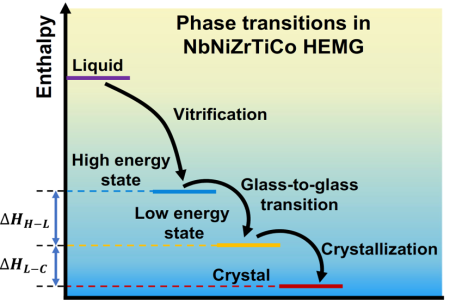
APRIL 26, 2022 New study from a team of scientists co-led by Dr. Qiaoshi Zeng from Center for High Pressure Science and Technology Advance Research reported a high-entropy-induced glass-to-glass transition in the NbNiZrTiCo high-entropy metallic glass. This glass-to-glass transition leads to a significant improvement of the modulus, hardness, and thermal stability. Their findings demonstrate that high configurational entropy could be a new dimension for tuning the glass states and properties in multi-component amorphous alloys. This work has recently been published in Nature Communications (DOI: doi.org/10.1038/s41467-022-29789-1). (-- more)
Two-way tuning of structural order in metallic glasses - Dr. Qiaoshi Zeng
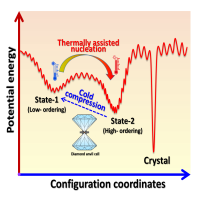 JUN. 16, 2020—Metallic glasses (MGs) are disordered alloys with many properties superior to conventional crystalline metals. Unlike crystalline materials that follow strict atomic-packing rules and imposed symmetry, in principle, metallic glasses have a high degree of freedom to arrange their atoms with almost infinite possibilities in their configuration space. However, in practice, effectively modulating the disordered structures of metallic glasses is rather challenging. A new study from a team of scientists led by Dr. Qiaoshi Zeng from HPSTAR realized a two-way tuning of structures between distinct states in metallic glasses by combining temperature and pressure. The results are published in the Jan. 16th issue of Nature Communications (DOI: 10.1038/s41467-019-14129-7). --more.
JUN. 16, 2020—Metallic glasses (MGs) are disordered alloys with many properties superior to conventional crystalline metals. Unlike crystalline materials that follow strict atomic-packing rules and imposed symmetry, in principle, metallic glasses have a high degree of freedom to arrange their atoms with almost infinite possibilities in their configuration space. However, in practice, effectively modulating the disordered structures of metallic glasses is rather challenging. A new study from a team of scientists led by Dr. Qiaoshi Zeng from HPSTAR realized a two-way tuning of structures between distinct states in metallic glasses by combining temperature and pressure. The results are published in the Jan. 16th issue of Nature Communications (DOI: 10.1038/s41467-019-14129-7). --more.
High-Entropy Alloy: changing faces under high pressure - Dr. Qiaoshi Zeng
 JUNE 2, 2017—A new study co-led by a HPSTAR staff scientist, Dr. Qiaoshi “Charles” Zeng revealed irreversible polymorphic phase transitions between the fcc and hcp structures in a prototype high-entropy alloy CoCrFeMnNi using in situ high pressure and high temperature x-xay diffraction techniques. Their discovery was just published in Nature Communications (DOI:10.1038/ncomms15687) on June 1st. These results shed new light on the thermodynamics and kinetics of complex HEA systems and also opens a new avenue towards tuning HEAs’ properties via polymorphic structural transitions for applications. --more
JUNE 2, 2017—A new study co-led by a HPSTAR staff scientist, Dr. Qiaoshi “Charles” Zeng revealed irreversible polymorphic phase transitions between the fcc and hcp structures in a prototype high-entropy alloy CoCrFeMnNi using in situ high pressure and high temperature x-xay diffraction techniques. Their discovery was just published in Nature Communications (DOI:10.1038/ncomms15687) on June 1st. These results shed new light on the thermodynamics and kinetics of complex HEA systems and also opens a new avenue towards tuning HEAs’ properties via polymorphic structural transitions for applications. --more
A general structural-property relationship in metallic glass - Charles Zeng
 Shanghai February 01, 2016 — Structure-property relationship is a central topic in materials science. In crystalline materials, the well-defined lattice structure or defects enable us to describe their properties quantitatively. The structure of glass is basically featureless, very few rigorous laws are currently known for defining its ‘disordered’ structure. Establishing general and exact rules regarding structure-property relationships in glass remain elusive. A breakthrough has been made by a international team led by Dr. Qiaoshi Zeng, a staff scientist from HPSTAR. This team established a general rule correlating the bulk properties (volume V) with most prominent atomic structure information (principle diffraction peak position q1) for metallic glasses, i.e. V∝(1/q1)2.5. It is shown that the 2.5 power law is strictly followed by any metallic glass with its volume tuned by pressure and/or composition. This general 2.5 power law is attributed to the well constrained structure change/modification inevitably happened during pressure and/or composition tuning of metallic glasses, which brings new insight into the structure of metallic glasses. These results are just published by PNAS. --more
Shanghai February 01, 2016 — Structure-property relationship is a central topic in materials science. In crystalline materials, the well-defined lattice structure or defects enable us to describe their properties quantitatively. The structure of glass is basically featureless, very few rigorous laws are currently known for defining its ‘disordered’ structure. Establishing general and exact rules regarding structure-property relationships in glass remain elusive. A breakthrough has been made by a international team led by Dr. Qiaoshi Zeng, a staff scientist from HPSTAR. This team established a general rule correlating the bulk properties (volume V) with most prominent atomic structure information (principle diffraction peak position q1) for metallic glasses, i.e. V∝(1/q1)2.5. It is shown that the 2.5 power law is strictly followed by any metallic glass with its volume tuned by pressure and/or composition. This general 2.5 power law is attributed to the well constrained structure change/modification inevitably happened during pressure and/or composition tuning of metallic glasses, which brings new insight into the structure of metallic glasses. These results are just published by PNAS. --more
Metallic glass: homogenous in appearance, fractal at heart - Dr. Qiaoshi Zeng & Dr. Wendy Mao
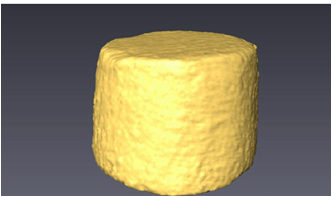 Shanghai September 18th, 2015 — The atomic structure of glasses has been a long-standing unsolved mystery in condensed mater physics and materials science. A breakthrough in understanding the atomic structure of an important new category of glass — metallic glasses was made by a joint research team including staff scientists of HPSTAR, Dr. Qiaoshi Zeng and Dr. Wendy L. Mao. From multiple techniques, the team found that a specific fractal model — the percolation cluster packing could provide a perfect explanation of the 2.5 power law observed in the compression experiments of metallic glasses and a unified description of the atomic structure of metallic glasses from short range to macroscopic length scale for the first time. These results are just published by Science (DOI: 10.1126/science.aab1233). --more
Shanghai September 18th, 2015 — The atomic structure of glasses has been a long-standing unsolved mystery in condensed mater physics and materials science. A breakthrough in understanding the atomic structure of an important new category of glass — metallic glasses was made by a joint research team including staff scientists of HPSTAR, Dr. Qiaoshi Zeng and Dr. Wendy L. Mao. From multiple techniques, the team found that a specific fractal model — the percolation cluster packing could provide a perfect explanation of the 2.5 power law observed in the compression experiments of metallic glasses and a unified description of the atomic structure of metallic glasses from short range to macroscopic length scale for the first time. These results are just published by Science (DOI: 10.1126/science.aab1233). --more
A universal fractional noncubic power law for density in metallic glasses - Dr. Qiaoshi Zeng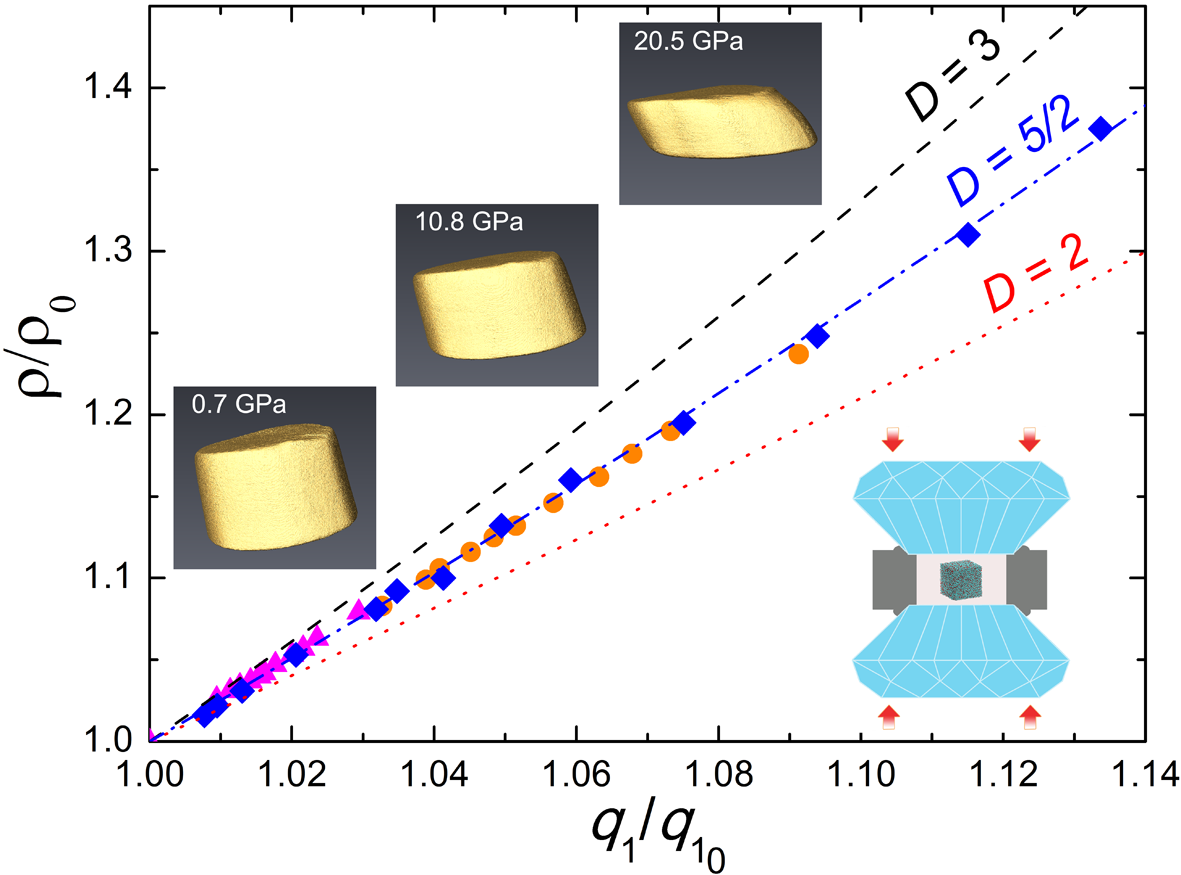 Tuning with pressure, a research team led by Dr. Qiaoshi Zeng with collaborators from HPSTAR, Stanford University, SLAC National Accelerator Laboratory, and Geophysical Laboratory at Carnegie Institution of Washington made a surprising discovery that the three-dimensional density of metallic glasses is not simply the cube of their one-dimensional average interatomic spacing, but varies with a universal 5/2 fractional power. The result is published by Phys. Rev. Lett. on May 8, 2014. --more
Tuning with pressure, a research team led by Dr. Qiaoshi Zeng with collaborators from HPSTAR, Stanford University, SLAC National Accelerator Laboratory, and Geophysical Laboratory at Carnegie Institution of Washington made a surprising discovery that the three-dimensional density of metallic glasses is not simply the cube of their one-dimensional average interatomic spacing, but varies with a universal 5/2 fractional power. The result is published by Phys. Rev. Lett. on May 8, 2014. --more